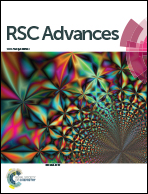Preparation of medical hydrophilic and antibacterial silicone rubber via surface modification†
Abstract
Bacterial adhesion of medical indwelling devices shortens their service life and brings about infections in patients. The combination of hydrophilic and antibacterial modifications can not only kill the bacteria in contact with the surface, but also avoid the adhesion of dead bacteria. From this view, with a self-made quaternary ammonium salt and a zwitterion as the modifiers, a modified silicone rubber, SR-g-(DMAPS-co-QA), was prepared via random co-grafting. The static water angle test and antibacterial assays proved the enhancement of both the hydrophilicity and antibacterial activity. In addition, compared with the unmodified silicone rubber, after 7 days of co-cultivation in E. coli suspension, SR-g-(DMAPS-co-QA) demonstrated good resistance to biofilm formation. Furthermore, to simulate the real situation, its antibacterial effect in dynamic flow condition was measured, confirming that SR-g-(DMAPS-co-QA) still maintained good antibacterial performance after a 48 hour cyclic flow of E. coli bacterial suspension.



 Please wait while we load your content...
Please wait while we load your content...